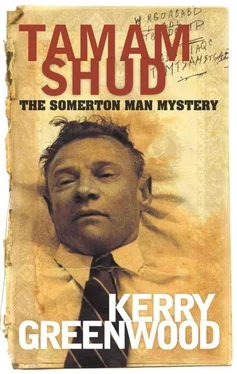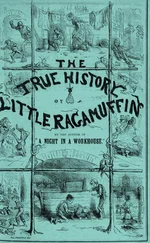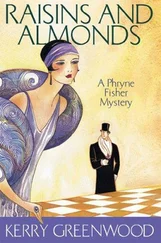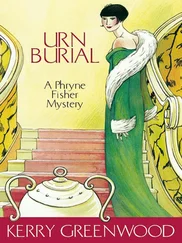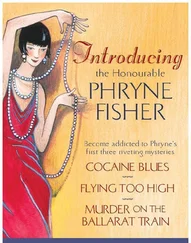Kerry Greenwood - Tamam Shud
Здесь есть возможность читать онлайн «Kerry Greenwood - Tamam Shud» весь текст электронной книги совершенно бесплатно (целиком полную версию без сокращений). В некоторых случаях можно слушать аудио, скачать через торрент в формате fb2 и присутствует краткое содержание. Город: Sydney, Год выпуска: 2012, ISBN: 2012, Издательство: NewSouth, Жанр: Детектив, Прочая документальная литература, на английском языке. Описание произведения, (предисловие) а так же отзывы посетителей доступны на портале библиотеки ЛибКат.
- Название:Tamam Shud
- Автор:
- Издательство:NewSouth
- Жанр:
- Год:2012
- Город:Sydney
- ISBN:978-1-742-23350-5
- Рейтинг книги:3 / 5. Голосов: 1
-
Избранное:Добавить в избранное
- Отзывы:
-
Ваша оценка:
- 60
- 1
- 2
- 3
- 4
- 5
Tamam Shud: краткое содержание, описание и аннотация
Предлагаем к чтению аннотацию, описание, краткое содержание или предисловие (зависит от того, что написал сам автор книги «Tamam Shud»). Если вы не нашли необходимую информацию о книге — напишите в комментариях, мы постараемся отыскать её.
Tamam Shud — читать онлайн бесплатно полную книгу (весь текст) целиком
Ниже представлен текст книги, разбитый по страницам. Система сохранения места последней прочитанной страницы, позволяет с удобством читать онлайн бесплатно книгу «Tamam Shud», без необходимости каждый раз заново искать на чём Вы остановились. Поставьте закладку, и сможете в любой момент перейти на страницу, на которой закончили чтение.
Интервал:
Закладка:
The suitcase contained the following items:
Red checked dressing gown
Red felt slippers, size 7
Undergarments – four pairs
Pyjamas
Four pairs of socks
Shaving kit containing razor and strop, shaving brush
Light brown trousers with sand in cuffs
A screwdriver
A cut-down table knife
A stencilling brush
A pair of scissors
A sewing kit containing orange Barbour’s waxed thread
Two ties
Three pencils
Six handkerchiefs
Sixpence in coins
A button
A tin of brown shoe polish, Kiwi brand
One scarf
One cigarette lighter
Eight large envelopes and one small envelope
One piece of light cord
One scarf
One shirt without a name tag
One yellow coat shirt (a shirt with an attached collar)
Two airmail stickers
One rubber (meaning an eraser)
One front and one back collar stud
Toothbrush and paste
So what can we make of these pitiful relics? As my father said, Somerton Man had good taste in clothes, though tending towards the gaudy. His case contained only enough for a few nights, a week perhaps. No extra shirts, for a start. This was a cleanly man who changed his clothes every day. He must have owned more shirts or what was the point of having more than one tie?
The most exciting discovery in the suitcase was the orange Barbour thread, which was not sold in Australia. Identical thread had been used to repair the pocket of Somerton Man’s coat. Waxed thread is not usually used to mend clothes: it must have been an emergency repair, intended to last only until he could lay hands on a seamstress. It seemed unlikely that the Barbour thread in the suitcase and the Barbour thread in Somerton Man’s coat were not connected, so the suitcase probably belonged to Somerton Man. Also, the clothes are his size and the slippers would fit his feet.
And some of the garments in the suitcase actually had labels with a name on them. There must have been cautious rejoicing amongst the exasperated police at that point, although they should have known it was too good to be true. The name, written on a singlet, a laundry bag and a tie, was T. Keane. Or possibly T. Kean. The call went out and a local sailor named Tom Reade was said to be missing. Was Somerton Man perhaps Tom Reade?
But when Tom Reade’s shipmates viewed the body, they all said that it was not their Tom Read. Meanwhile widespread searches through maritime agencies had revealed that no one was missing a T. Keane or Kean. Rats (or the equivalent), one can hear the law enforcement persons say.
The clothes were also marked with drycleaning or laundry marks, which were applied to clothes when they were submitted for cleaning, so that the cleaner could identify them if their tag was lost. These marks were 1171/1 and 4393/7 and 3053/7 but extensive searches of laundries and drycleaners found no one who used those combinations of numbers. Notably, the only marked clothes in the suitcase, which also had a name on them were those where the name could not be removed without destroying the garment – for instance, the singlet, where the name was written inside the band in indelible ink. And it also seems reasonable to assume that Somerton Man left the names where they were because he knew that he was not Tom or any other Kean(e) – not Terence, Tipton, Trevelyan and so on. Besides, it is unusual to buy second-hand underwear. Even if you are very poor, you usually save to buy new knickers. I speak from personal experience.
So why did Somerton Man have T. Keane’s laundry bag? It’s another mystery: this matter has a plethora of them. Tom Keane was said to be a sailor, so the laundry marks may relate to a ship’s laundry. Somerton Man might have been on the same ship as Tom Keane and picked up his laundry by mistake – although that doesn’t explain the tie, given that ties are drycleaned, not laundered. Somerton Man might also have deliberately swapped his own marked garments for similar garments belonging to Tom Keane, who would probably not mind, as long as he got a singlet of some sort, although it was not kind to nick Tom Keane’s tie as well. If the name on Somerton Man’s own tie was a problem, he could have adopted the solution used when I was a child – blacking out the old name in Indian ink and writing your own beside it. Indian ink is really black.
The clothes were all examined by experts. The police called in a tailor, Hugh Possa of Gawler Place, who explained that the careful construction of the coat, with feather- stitching done by machine, was definitely American, as only the American garment industry used a feather stitching machine. So the clothes were very high value schmutter indeed. Such coats, the police were informed, were not imported. They were made up to a certain stage and then could be quickly tailored to the figure. The sort of thing which might be bought by someone who wasn’t staying long in port, but was willing to pay a high price for a beautifully made, hand-finished suit. From which he then removed the label.
Somerton Man also had very snazzy taste in nightwear. His pyjamas and gown are brightly coloured, and his felt slippers are red. My father’s taste also tended to the bright. I have a Hawaiian shirt of his that can only be viewed through dark glasses. Such things were a mark of a free spirit. Men of the time might have considered these garments to be outrageous, even effeminate. That is another thing we will never know.
It is interesting that there was sand in the cuffs of the trousers in the suitcase. Unfortunately, although its presence was noted, the sand was not examined or analysed. In the same cuffs were stumps of barley grass, which is the stuff that grabs any passing cloth and screws itself into the weave. (It has to be cut out of cat’s fur and children’s hair, because it’s as adhesive as bubble gum.) Everyone always assumes that Somerton Man had just arrived in Adelaide on the day he died but the sand in the cuffs might mean that he had been to Somerton Beach before he arrived at the station and maybe changed his clothes afterwards. Or was he landed, perhaps, with his suitcase, on another beach, brought ashore by dinghy from a ship, walking the last little way across the sand and hoping – successfully, as it happens – to avoid notice? After which, a snappy dresser might have folded those trousers into his suitcase, still with sand in the cuffs, and put on fresh ones.
Somerton Man’s shoes were clean, however, and looked to have been recently polished. He can’t have walked ashore in them. Seawater does very nasty things to leather shoes. Did he tippytoe barefoot through the waves with his shoes in his hand? Did he put them on when his feet dried and stop at the shoeshine stand near the station, after he had his wash and checked his suitcase? My father said that the Central Station shoeshine man did a wonderful job, even on army boots. If so, Somerton Man must have paid him with his very last tuppence in the world.
Last but not least, my father, drawing on his experience as a wharfie, told me that the stencilling brush, the modified knife, the screwdriver, pencils and the scissors found in Somerton Man’s suitcase were all part of a cargo master’s equipment – the stencilling brush for marking cargo and the other items for cutting or replacing seals. Cargoes were more fun back in those days. Instead of containers, which are anonymous and boring, balanced for weight, there were bales and sacks and boxes and crates, all carried by men out of ships and along gangplanks. Hard labour.
My father always said that 120 pounds of grain was a lot easier to carry than 90 pounds of potatoes. I couldn’t carry 120 pounds (or 50 kilos) of grain if my life depended on it but they did, for eight hours, up and down and along, from the hold to the deck to the truck or railway flatbed. Sometimes the bales and sacks and boxes and crates were taken up to the deck and swung out on cargo nets. That’s why wharfies had cargo hooks, formidable little hand weapons, used for handling cargo, cleaning fingernails and settling differences of opinion. Working on the docks was called ‘being under the hook’ because another hook was holding up those nets, attached to a derrick, or crane, and handled with extreme care and delicacy.
Читать дальшеИнтервал:
Закладка:
Похожие книги на «Tamam Shud»
Представляем Вашему вниманию похожие книги на «Tamam Shud» списком для выбора. Мы отобрали схожую по названию и смыслу литературу в надежде предоставить читателям больше вариантов отыскать новые, интересные, ещё непрочитанные произведения.
Обсуждение, отзывы о книге «Tamam Shud» и просто собственные мнения читателей. Оставьте ваши комментарии, напишите, что Вы думаете о произведении, его смысле или главных героях. Укажите что конкретно понравилось, а что нет, и почему Вы так считаете.
